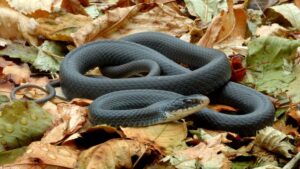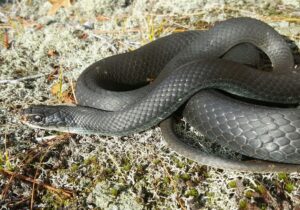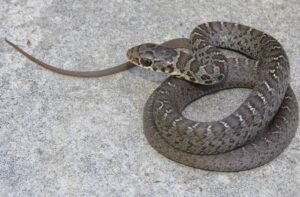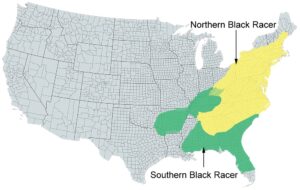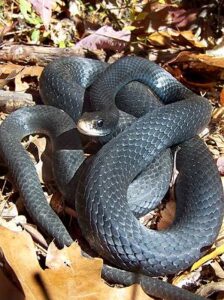Northern Black Racer (Coluber constrictor constrictor)
Updated on
25/04/2024The northern black racer is a subspecies of the eastern racer and the state reptile of Ohio. The long, shiny black snake is terrestrial and diurnal. It is active from April to September.
Scientific Classifications
- Suborder:Serpentes
- Family:Colubridae
- Genus:Coluber
- Species:C. constrictor
- Subspecies:C. c. constrictor
Conservation Status
Description
Size
Their total length, including the tail, is in the range of 36-60 in (90-152 cm). The maximum recorded length is 70.7 in (179.5 cm).
Color and Appearance
The body of the northern black racer is uniformly black on the dorsal side and dark gray on the ventral side, with the tail’s venter being uniformly light gray. The head is black, except for the anterior part of the snout, which is brownish. The chin and a variable region of the venter of the neck are white. There is also some white pigmentation on the supralabial scales in some individuals. Smooth scales cover the body and the large eyes have circular pupils.
The juveniles have a light-gray to brown body with a dorsal pattern of dark-gray to reddish-brown blotches. They have a cream-colored venter that may be plain or have an irregular series of black dots. The pattern fades with age and completely disappears when the snake is around 3 years old.
Are They Dangerous to Humans
If agitated or cornered the snake the non-venomous snake can expel musk, discharge feces, or lash out in defense and bite.
Northern Black Racers at a Glance
Distribution
It ranges from Alabama, Georgia, and Mississippi in the south, to Vermont, central New York, Maine, and New Hampshire in the north, to Tennessee, eastern Ohio, and Kentucky in the west.
Habitat
It occupies areas with large patches of open habitats like open, grassy areas or open forests adjacent to grassy areas. The colubrid prefers xeric habitats and occupies urban and agricultural areas, as well as grasslands in the mountains and barrier islands.
It can be spotted crossing roads during the day when many are killed.
Lifespan
It lives for up to 10 years in the wild.
Predators
The northern black racer is eaten by Birds of prey such as hawks, coyotes, and domestic cats and dogs eat the northern black racer.
Diet
It preys on other smaller snakes, frogs, toads, chipmunks, small birds, shrews, mice, and other small rodents, and invertebrates such as moth and butterfly larvae, spiders, and various other insects.
Despite its scientific name, the northern black racer does not constrict to kill its prey. It pins its food with its body loops and swallows it alive.
Reproduction
Oviparous (lays eggs that hatch outside the body)
A clutch of 3-32 eggs is laid in June-July, which hatch in August-September. The eggs have a granular structure and are hidden in burrows, under logs, or in a nest cavity in sand or leaf litter. Sexual maturity occurs in 2-3 years for females and 1-2 years for males.
Source
i.pinimg.com, vtherpatlas.org, marylandbiodiversity.com, virginiaherpetologicalsociety.com, fbcdn.net

